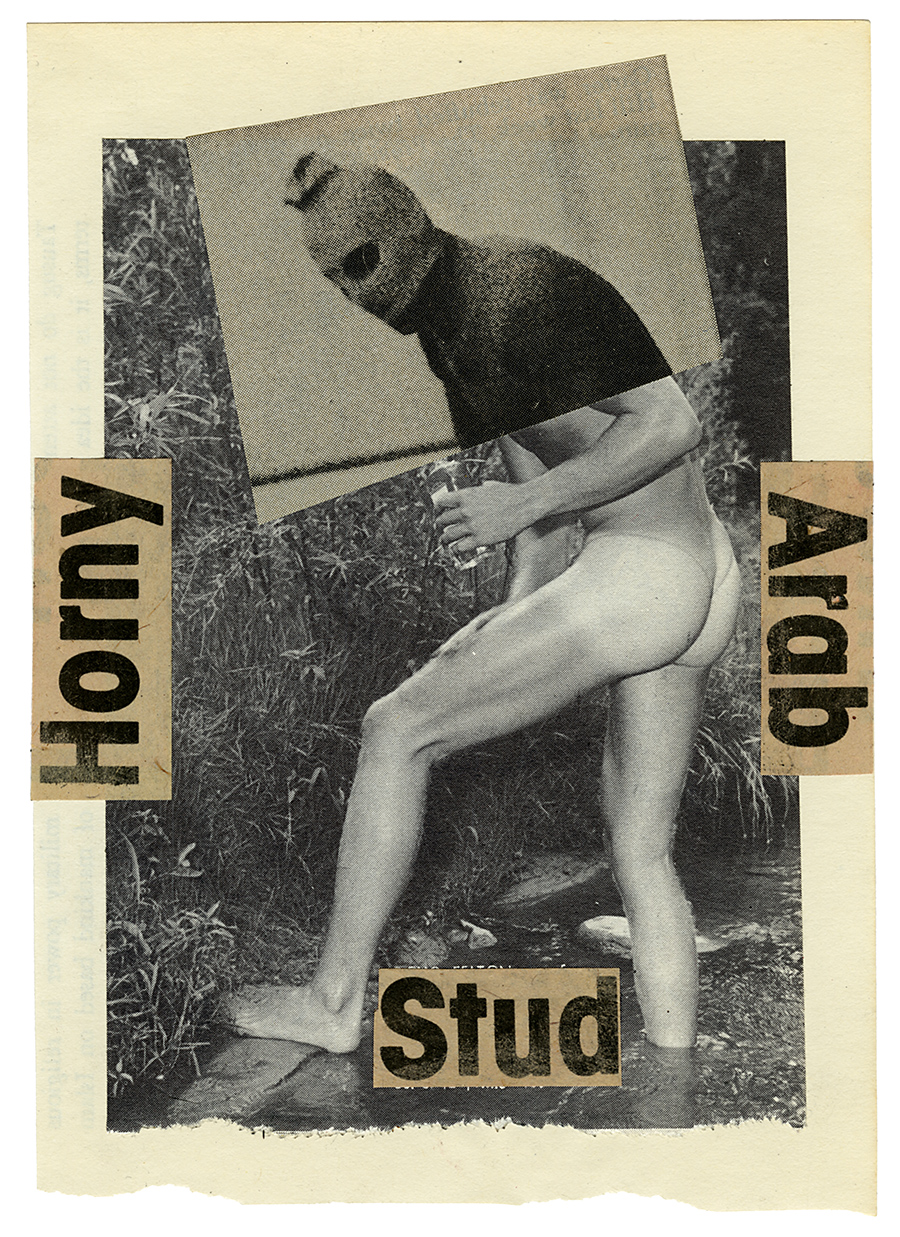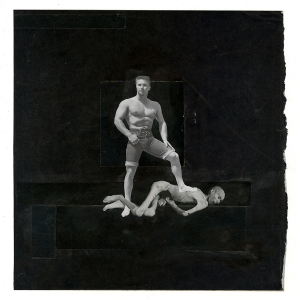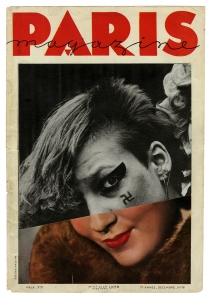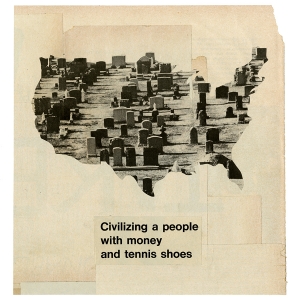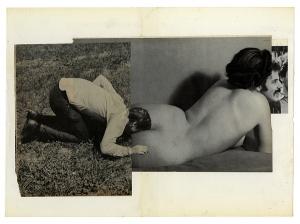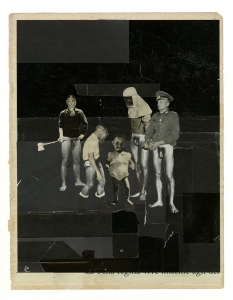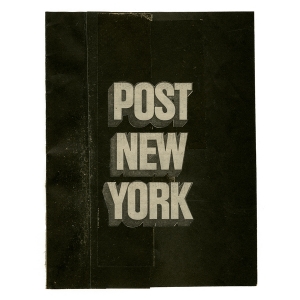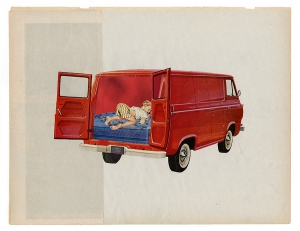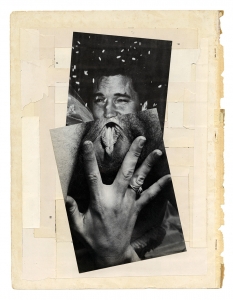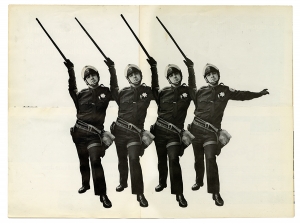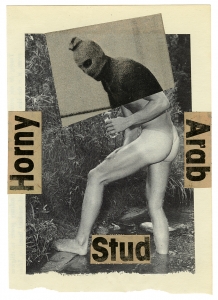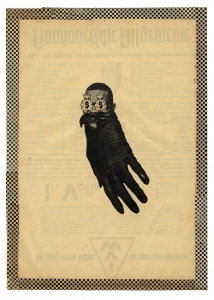Jason Moore has few boundaries. In any particular series of his collages you can find a loose inventory of imagery that includes bare breasts, atomic bomb explosions, skeletons, dicks, vintage porn, guns, black eyes, cops, death, decay, vaginas, skateboards, mosques, skulls and nuns. His cache of symbols seems to leave no trash bin unturned, no corner of ebay unrummaged.
Moore then assembles his findings, along with the occasional cut-out newspaper headline, into collages made on scraps of yellowed and vintage paper, shoehorning energetic, irreverent and often surprisingly witty notions. His pieces recapture something of the sloganeering, kick-ass essence of Dadaist collage while also revealing a multi-faceted personality seemingly torn between reflection and reaction. Moore’s refusal to have any kind of doctrine spoon-fed to him or to base his decisions on any social structure translates in each of his creations.
While the cut-and-paste model has been imitated countless times, Moore’s style resonates as some of the most caustic and evocative, placing porn-ready genitals on uniformed men and young boys, ass up, on soiled mattresses, in the back of sketchy vans. His way of merging the political and the sexual grabs your attention with nudity, keeps it there with humor and forces you to dwell on bigger questions of violence, gender, identity and consumerism.
We recently had a chance to catch up with Moore who told us about the Per Welinder street board that changed his life, shoving a giant paper cock through the Iwan of a mosque, and why punk has remained a constant thread in his work.
Tell me a little about your background; what were you like in high school? I know you’re originally from AZ, when did you make your way to LA and what brought you? What was your initial reaction to the city?
My name is Jason but I’ve been using the moniker Nil Ultra since the fall of 1998, while living in New York. In high school I started out as a shy skater kid as my parents had just up and relocated us to the mountain town of Flagstaff, Arizona after I had spent my elementary years in Mesa and Chandler. Flagstaff was a far cry from the vibes and ideals I was subjected to in the rural track homes of Chandler. I had a lot of friends who were Mormon or Christian and always hyped on Jesus cartoons and action figures I had never heard of. I thought they were generic versions of what was really cool like He-Man, G.I. Joe, Transformers. I listened to Beastie Boys, RUN-DMC, Hendrix, and Zeppelin. I don’t know what the fuck those kids were listening to, I just knew it was corny and strange.
I grew up in a pretty musical household and both my parents were cool enough to take me to some epic shows as a kid. Three of my first shows were Zappa; one of which I was in diapers. Anyways, I had a hard time relating to the neighborhood kids. I remember this one dude Eric; a heavyset red-headed dude, whose parents had a ton of dough. We would have these big sleepovers together and he had all these Christian video games I didn’t know how to play, and we’d watch videos of The Power Team on their big screen. The other kids all knew what this stuff was and they went nuts for it. The Power Team were these ex-wrestler dudes who found God after beating their wives or getting caught smoking crack with trannies. The Power Team ended up filling stadiums full of screaming kids hyped on seeing them bend steel pipes and smash bricks over their heads with the power of Jesus. You can probably dig those shows up on YouTube. Shit’s a trip, man.
It was in Flagstaff where I found the punk scene and the skater crowd. Being that it was a small town, we all united and joined forces against the cliché jocks and poser cowboys. Those dudes loved calling us fags and hippies. I never understood that. I’m pretty down with titties and aside from being a Dead fan, hippies can fuck off. With my folks being really distant from each other for many of my formative years – they eventually split up – I spent most of my time with my mom. She took me on a lot of memorable trips to Southern California to visit my aunt and my cousins, who I treat as my sisters. The vibe in Southern California and open-mindedness is something that stuck with me and drove me here after a decade of fucking off in other parts of the country like Manhattan, Denver, Phoenix again, and Flagstaff again. I even tried San Diego, which is basically Phoenix with a beach. That place was pretty boring aside from Hillhurst, at the time. Although San Diego is where I bought a copy of a Communication Arts that had a unforgettably inspiring feature on Shepard Fairey, who by total coincidence, luck, and hope, I now have the privilege of working with everyday as an Art Director.
My first few years out here in LA were spent abandoning my training in magazine art direction and agency work. I dove right into film, TV, and ad production through a good friend I met and worked with in Boulder. He had relocated to LA and was becoming a well-known production designer. I rode along with him for several years doing everything from set dressing, building, props, and eventually being a prop master and lead man before bowing out of that and focusing on art and freelance design and art direction.
When did you first start skating? In what ways did/does skating and skate culture converge with your art? How do you think the two – skateboarding and art – go hand in hand?
Skateboarding has always been a big part of my life. My first board was a banana yellow Variflex my mom bought me for Christmas. I was maybe 8 years old. By the time I was 12, I was buying boards at the Bare Cover in Chandler, AZ strictly based off the graphics. I had already been drawing since I could hold a pencil and was into faces, heads, and skulls, so all those VCJ Powell-Peralta graphics were right up my alley. I can’t remember what year it was, but the Per Welinder street board was what changed everything for me. That heraldic, screaming skull with all that viking scribble was awesome. I skated the nose and tail off that thing before switching to a Natas panther deck. I remember always having bright blue Powell T-Bones and finger molded madrid rails on every deck I rode.
I think skateboarding and art go hand in hand as they are both outsiders of what they’re accidentally labeled. In other words, skateboarding, for all intents and purposes of the word, is not truly a sport; I’d say it’s a hobby of expression, an art if you will. Most skaters back in the day, and many still to this day, are outsiders. So it makes sense for the art of the board to be “outside” of art. Call it low-brow, call it what you will, but there are so many talented skateboard artists.
The 80’s dudes ruled; VCJ, Pushead, Jim Philips, then your 90’s guys like McKee and Cliver and some of the shit coming out of Alien Workshop was amazing. I remember riding a slick version of that Pitre deck with the man made of matches. The idea of a propped out photo being applied on the whole bottom of the board was really appealing. Kids have liked shitty graphics for too many years now. The higher-ups at the larger skate companies tend to be money-hungry bozos with fake credentials and no business being in skateboarding. It’s always these dudes coming in wearing that old man surf gear or some frumpy lady in mule clogs that convince our favorite companies, “We gotta sell to Zumiez! We need more SMUs! Make that thing tie-dye! Logo boards! Logo Boards!” Then they weed out all the riders who aren’t kissing ass or repping Street League. It’s fucking wack.
All that aside, there are some great brands that don’t depend on some busted-ass distro run by bro-bros and burnouts who missed out on being cool. I’m a big fan of companies like Welcome, Isle, Magenta, F.A./Hockey, Bronze56k, and all the good stuff coming out of Australia. These brands are a breath of fresh air and are needed to push out all this stale garbage from the last 10-15 years. Some weird boards are being made, silk screening is finally back. It’s all stuff that is expanding skateboarding and the art even further. Skateboarding is always changing and brands come and go, but right now it’s really global and inspiring.
What’s your creative process like? From idea generation to the execution itself. Do you have an idea in your head and then you scour magazines looking for specific imagery that you’ve already envisioned for a piece, or is it a more natural, stumble-upon-the-imagery type process?
The answer is: all of the above, really. Sometimes I can see a visual joke I’d like to tell and then the hunt begins for the right elements. This could take a couple hours in the back room going trough old magazines and random ephemera or it could be weeks or months of waiting on that stumble.
The other could be, say a current event like the Paris shootings, where I knew immediately that I had to offend some people and make some jokes. My father is a Muslim; has been since I was 17. I am now 37. So, I feel I have a duty and a strange, unorthodox view that gives me the ability to tell a story I doubt anyone else would. At least not through collage. The same goes for my views on how women have been treated in the past, and how the LGBT community has struggled and been forced to be in hiding or feel ashamed. My mom came out to me when I was 22, and I grew up around gay uncles who I’ve always admired and am very close to. One uncle even lived as a woman through much of the 70s as “Winona” – what’s up Uncle Wayne! I remember his stories of losing friends to AIDS during his years in San Francisco, long before Elton was writing songs about it and white people were jogging with red ribbons. The world, for the most part, now allows all my uncles to do whatever the hell they want to do and allows my mom to feel comfortable finding companionship with whoever she wants.
As for pops? He’s a trip, and on the rare occasion I hear from him, it’s typically a diatribe on where I live and how LA is a den of iniquity and a target for every evil cell out there. “You need to arm yourself and move to fly-over country.” Pops needs to chill. But if he did, I wouldn’t have so much fun shoving a giant paper cock through the Iwan of a mosque. Aizdihar!
Do you consider yourself a political artist?
Only when I’m making political art.
Tell me more about your newest series “Stezaker Called”. How and why did you decide to create in the same vein as John Stezaker’s photographic collages? Where do you get/find most of these photographs?
When I first committed to collage I tried too hard, as do most people when going at a new technique or artistic avenue. I had always avoided doing what he does as I had the mindset that “he already did it,” but then I realized, collage is already done. He just executed something. He exercised something. He also doesn’t take it serious and nor should anyone else, but they do. It’s a beautiful thing. I look at Stezaker exercises as great ways to continue studying proportion, lighting, and of course creepiness. I find “vintage lots of headshots” on ebay (read carefully to avoid reproductions). My materials must pre-date July of 1978. That’s my only rule. Well, that and absolutely no digital. I’ll leave that to the kids who wanna make cheeseburgers glitch and twitch in the center of a Grand Canyon photo. They do a great job of that.
Do you think the political edge/social critique that your collages hold stand as the essence of these pieces? Could you make the same statements and relay the same notions that you do in pieces like those of “Remain Sedate” in another medium? Or do you see collage as the only way for you to convey your point?
Oh, these could absolutely be in any other medium. Not just collage or even visual. Most of what you see in the “Remain Sedate” was in reference to the Rorschach album of the same name. I mixed some of what Charles Maggio was writing about with some of my current views on sexuality and violence, along with what I had been inspired by when apprenticing for Cleon Peterson. That work was a tribute to Maggio, Peterson, as well as a sort of fantasy alternate history a la Philip K. Dick where buff, gay Jew bears rule the world. It’s all in there, I swear.
People could easily equate your cut and paste style with punk – collage was absolutely crucial to punk – from fanzine art to the music and the clothes. How important is/was punk in terms of your development as an artist?
Punk is very important. Since my teens I’ve been influenced by all the anarcho stuff that went on in the late 70s and early 80s in England. I hung around a lot of older cats who would soapbox rant all night after spare-changing for 12-packs of Oly in front of the coffee shop. I took what I needed to heart. There’s only so much you can get out of a white line cook named Spider who’s rambling on about the plight of the Native American or his views on the Falklands. Those kind of dudes did turn me on to some amazing music though. So I thank them for my liner note education and introduction to artists like Gee Vaucher, Wintston Smith, and Raymond Pettibon.
Where does the moniker Nil Ultra come from?
I stole it from a friend back in ’99 when I was living in the New York and while he was attending Antioch for some liberal arts degree or some philosophy shit. We would communicate via AOL chat and one day he had changed his screen name to “Nil Ultra” and when I asked what it meant he said something about it meaning “Nothing Beyond This” and it really stuck with me. I lifted it with his blessing and have hung onto it since. He’s now a criminal defense lawyer for drug trafficking.
Favorite thing you’ve cut out recently?
Beef and alcohol.
Favorite vintage magazine to flip through?
Porn. Definitely porn.
Weirdest image you’ve ever incorporated in a collage?
Probably this image from a mattress ad of a sleeping boy with his ass up in the air. I put him in back of a van and stained the mattress just a bit. That piece has been exhibited at least five times and has never sold. Touchy stuff, I guess.
What imagery is currently catching your eye? Find anything specific you keep coming back to?
Huge cocks. They’re hard to miss.
For more from Nil Ultra head to http://www.nilultra.com/.
- Photo: We Are The Rhoads


